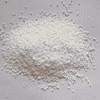
Benzoic acid, its salts and derivatives
Moderate risk
Alternate Names:
- benzoic acid
Info from food-info.net:
- Description:
- Function:
- Benzoic acid and benzoates are used as preservatives against both yeasts and fungi in acidic products. They are not very effective against bacteria and ineffective in products with a pH above 5 (slightly acidic or neutral). High concentrations result in a sour taste, which limits the application. Benzoates are often preferred, due to better solubility.
- Origin:
- Benzoic acid, benzoates and benzoic acid esters are commonly found in most fruits, especially berries. Cranberries are a very rich source of benzoic acid. In addition to fruits, benzoates occur naturally in mushrooms, cinnamon, cloves and some dairy products (due to bacterial fermentation). For commercial purposes, it is prepared chemically from toluene.
- Side effects:
- No side effects in the concentrations used. In some people benzoic acid and benzoates may liberate histamine and thus cause pseudo-allergic reactions.
Dietary restrictions:- None - benzoic acids and benzoates can be consumed by all religious groups, vegans and vegetarians.
Acceptable daily intake:- Up to 5 mg/kg body weight.
Status:- Unknown
Info from proe.info:
- Description:
- Benefits:
- Unknown
- General:
- Unknown
- Harm:
- Unknown
- Legal:
- Unknown
- Use:
- Unknown
- Links:
- Unknown
Dietary restrictions:- Unknown
Acceptable daily intake:- Unknown
Status:- Unknown
ninamvseeno.org -- site no longer live
- Description:
- Unknown
Dietary restrictions:- Unknown
Acceptable daily intake:- 5,000 mg/kg body weight/day (EFSA, 2016)
Status:- Approved in the EU.
References: